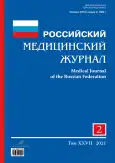Peculiarities of outpatient care for COVID-19 patients using telemedicine technologies
- Authors: Tyazhelnikov A.A.1,2, Polunina N.V.2, Kostenko E.V.2,3, Polunin V.S.2
-
Affiliations:
- Consultative diagnostic clinic No. 121
- N.I. Pirogov Russian National Research Medical University
- Moscow Scientific and Practical Center for Medical Rehabilitation, Restorative and Sports Medicine of the Moscow City Health Department
- Issue: Vol 27, No 2 (2021)
- Pages: 107-114
- Section: Health care organization and public health
- URL: https://journals.rcsi.science/0869-2106/article/view/76370
- DOI: https://doi.org/10.17816/0869-2106-2021-27-2-107-114
- ID: 76370
Cite item
Abstract
BACKGROUND: The use of telemedicine in providing outpatient care for COVID-19 patients is an integral part of the most intensively developing and promising areas of national health care.
AIM: This study aims to demonstrate the efficiency of using telemedicine technologies in outpatient care for COVID-19 patients.
MATERIALS AND METHODS: This study is the retrospective analysis of remote consultations for 57,256 patients with COVID-19 from April 1, 2020, to May 24, 2020.
RESULTS AND DISCUSSION: The results of human resource analyses, the physician workloads, and the categories of observed patient categories are presented. The majority of patients were asymptomatic (45%), a mild form of the disease was observed in 4534 (34%) patients, and moderate cases were observed in 2800 (21%) patients. Concomitant pathology was observed in 60.0% of patients. The capacity of the telemedicine center was 52.8 patients for one physician per shift.
CONCLUSIONS: The telemedicine structure of the center, which regulates the interactions of physicians with patients and other healthcare facilities, has enabled the appropriate use of human resources to ensure that therapeutic, diagnostic, and epidemiological activities are adequate and timely in outpatient settings.
Keywords
Full Text
##article.viewOnOriginalSite##About the authors
Andrey A. Tyazhelnikov
Consultative diagnostic clinic No. 121; N.I. Pirogov Russian National Research Medical University
Author for correspondence.
Email: kdp121@zdrav.mos.ru
ORCID iD: 0000-0002-2191-0623
MD, Cand. Sci. (Med.)
Russian Federation, 87 Youthbutovskaya str., 117042, Moscow; MoscowNatalya V. Polunina
N.I. Pirogov Russian National Research Medical University
Email: nvpol@rambler.ru
ORCID iD: 0000-0001-8772-4631
MD, Dr. Sci. (Med.), Professor, Academician of the Russian Academy of Sciences
Russian Federation, MoscowElena V. Kostenko
N.I. Pirogov Russian National Research Medical University; Moscow Scientific and Practical Center for Medical Rehabilitation, Restorative and Sports Medicine of the Moscow City Health Department
Email: ekostenko58@mail.ru
ORCID iD: 0000-0003-0629-9659
MD, Dr. Sci. (Med.), Professor
Russian Federation, Moscow; MoscowValery S. Polunin
N.I. Pirogov Russian National Research Medical University
Email: lunapol@yandex.ru
ORCID iD: 0000-0002-2681-8527
MD, Dr. Sci. (Med.), Professor
Russian Federation, MoscowReferences
- Levanov VM, Orlov OI, Merekin DV. Historic periods of development of telemedicine in Russia. Information technologies for the physician. 2013;(4):67–73. (In Russ).
- Maksimov IB, Diashev AN, Sinopalnikov VI, et al. Telemedicine: history, analysis of a state and prospects. The journal of telemedicine and e-Health. 2018;(3):103–110. (In Russ). doi: 10.29188/2542-2413-2018-4-3-103-110
- Shepel PN, Kutcher AV, Vakhovskaya TV, Drapkina OM. History of telemedicine in the Russian Federation. Emergency cardiology and cardiovascular risks. 2019;3(2):765–771. (In Russ).
- Evdokimov VI, Esaulenko IJe, Aleksanin SS, et al. Razvitie i analiz nauchnyh issledovanij po telemedicine (2008–2017 gg.). Moscow: Nauchnaja kniga; 2019. (In Russ).
- Vladzymyrskyy AV. Patient initiated direct-to-consumer telemedicine consultations: first step for a methodology systematization. The journal of telemedicine and e-Health. 2017;(4):109–120. (In Russ). doi: 10.29188/2542-2413-2017-3-2-109-120
- Vladzymyrskyy AV. Efficiency of direct-to-patient telemedicine consultations: status praesens. The journal of telemedicine and e-Health. 2018;(3):64–70. (In Russ). doi: 10.29188/2542-2413-2018-4-3-64-70
- Ilushin GY, Limansky VI. Delivery of health care to the population using mobile telemedicine systems. Systems and means of informatics. 2017;2(1):122–133. (In Russ). doi: 10.14357/08696527170109
- The order of the Ministry of Health of Russia, November 30, 2017 No 965 "Ob utverzhdenii porjadka organizacii i okazanija medicinskoj pomoshhi s primeneniem telemedicinskih tehnologij". Available from: https://rg.ru/2018/01/11/minzdrav-prikaz965n-site-dok.html (In Russ).
- Melik-Guseinov DV, Khodyreva LA, Turzin PS, et al. Telemedicine: regulatory support, realities and prospects for use in domestic health care. Experimental & clinical urology. 2019;(1):4–10. (In Russ). doi: 10.29188/2222-8543-2019-11-1-4-10
- Morozov SP, Vladzymyrskyy AV, Simenyura SS. The quality of primary direct-to-consumer telemedicine consultations (by results of testing telemedicine services). Information technologies for the physician. 2020;(1):52–62. (In Russ). doi: 10.37690/1811-0193-2020-1-52-62
- Akulin IM, Chesnokova EA, Presnyakov RA, et al. Procedure for conducting telemedicine consultations in the subjects of the Russian Federation. Information technologies for the physician. 2020;(3):49-59. (In Russ). doi: 10.37690/1811-0193-2020-3-49-59
- Lukoshkova AS, Divankov DS, Cybul’skij KK. Telemedicine Telemedicinskie tehnologii kak sredstvo povyshenija jeffektivnosti okazanija grazhdanam pervichnoj mediko-sanitarnoj pomoshhi. Molodoj uchenyj. 2020;(6):94–96. (In Russ).
- Order of the Ministry of Health of Russia, October 30, 2020 No 1184n «O vnesenii izmenenij v prikaz Minzdrava Rossii ot 19.03.2020 No 19. S. 8n (red. ot 04.12.2020) "O vremennom porjadke organizacii raboty medicinskih organizacij v celjah realizacii mer po profilaktike i snizheniju riskov rasprostranenija novoj koronavirusnoj infekcii COVID-19". Available from: http://publication.pravo.gov.ru/Document/View/0001202011120037. (In Russ).
Supplementary files






